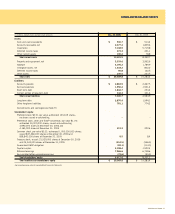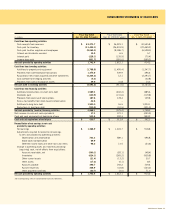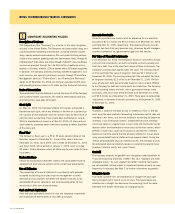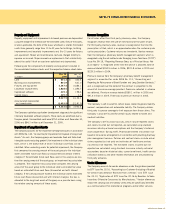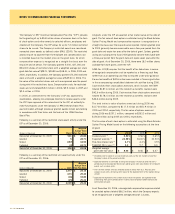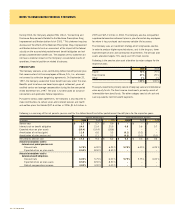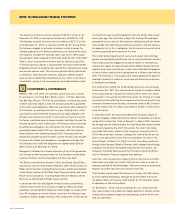CVS 2006 Annual Report Download - page 39
Download and view the complete annual report
Please find page 39 of the 2006 CVS annual report below. You can navigate through the pages in the report by either clicking on the pages listed below, or by using the keyword search tool below to find specific information within the annual report.
36 CVS Corporation
NOTES TO CONSOLIDATED FINANCIAL STATEMENTS
Stock-Based Compensation
On January 1, 2006, the Company adopted SFAS No. 123(R),
“Share-Based Payment,” using the modified prospective transition method.
Under this method, compensation expense is recognized for options
granted on or after January 1, 2006, as well as any unvested options on
the date of adoption. As allowed under the modified prospective transition
method, prior period financial statements have not been restated. Prior to
January 1, 2006, the Company accounted for its stock-based compensation
plans under the recognition and measurement principles of Accounting
Principles Board (“APB”) Opinion No. 25, “Accounting for Stock Issued
to Employees,” and related interpretations. As such, no stock-based
employee compensation costs were reflected in net earnings for options
granted under those plans since they had an exercise price equal to the
fair market value of the underlying common stock on the date of grant.
See Note 7 for further information on stock-based compensation.
Income Taxes
The Company provides for federal and state income taxes currently
payable, as well as for those deferred because of timing differences
between reported income and expenses for financial statement purposes
versus tax purposes. Federal and state incentive tax credits are recorded
as a reduction of income taxes. Deferred tax assets and liabilities are
recognized for the future tax consequences attributable to differences
between the carrying amount of assets and liabilities for financial reporting
purposes and the amounts used for income tax purposes. Deferred tax
assets and liabilities are measured using the enacted tax rates expected
to apply to taxable income in the years in which those temporary differences
are expected to be recoverable or settled. The effect of a change in tax
rates is recognized as income or expense in the period of the change.
Earnings per Common Share
Basic earnings per common share is computed by dividing: (i) net
earnings, after deducting the after-tax Employee Stock Ownership Plan
(“ESOP”) preference dividends, by (ii) the weighted average number of
common shares outstanding during the year (the “Basic Shares”).
When computing diluted earnings per common share, the Company assumes
that the ESOP preference stock is converted into common stock and all
dilutive stock awards are exercised. After the assumed ESOP preference
stock conversion, the ESOP Trust would hold common stock rather than
ESOP preference stock and would receive common stock dividends
($0.1550 per share in 2006, $0.1450 per share in 2005 and $0.1325 per
share in 2004) rather than ESOP preference stock dividends (currently
$3.90 per share). Since the ESOP Trust uses the dividends it receives to
service its debt, the Company would have to increase its contribution to the
ESOP Trust to compensate it for the lower dividends. This additional
contribution would reduce the Company’s net earnings, which in turn,
would reduce the amounts that would be accrued under the Company’s
incentive compensation plans.
provided. Funds that are directly linked to advertising commitments are
recognized as a reduction of advertising expense in the selling, general
and administrative expenses line when the related advertising commitment
is satisfied. Any such allowances received in excess of the actual cost
incurred also reduce the carrying cost of inventory. The total value of
any upfront payments received from vendors that are linked to purchase
commitments is initially deferred. The deferred amounts are then amortized
to reduce cost of goods sold over the life of the contract based upon
purchase volume. The total value of any upfront payments received from
vendors that are not linked to purchase commitments is also initially
deferred. The deferred amounts are then amortized to reduce cost of
goods sold on a straight-line basis over the life of the related contract.
The total amortization of these upfront payments was not material to
the accompanying consolidated financial statements.
Store Opening and Closing Costs
New store opening costs, other than capital expenditures, are charged
directly to expense when incurred. When the Company closes a store, the
present value of estimated unrecoverable costs, including the remaining
lease obligation less estimated sublease income and the book value of
abandoned property and equipment, are charged to expense. The long-term
portion of the lease obligations associated with store closings was
$418.0 million, $406.3 million, and $507.1 million in 2006, 2005
and 2004, respectively.
Advertising Costs
Advertising costs are expensed when the related advertising takes place.
Advertising costs, net of vendor funding, which is included in selling,
general and administrative expenses, were $265.3 million in 2006,
$206.6 million in 2005 and $205.7 million in 2004.
Interest Expense, Net
Interest expense was $231.7 million, $117.0 million and
$64.0 million, and interest income was $15.9 million, $6.5 million
and $5.7 million in 2006, 2005 and 2004, respectively. Capitalized
interest totaled $20.7 million in 2006, $12.7 million in 2005 and
$10.4 million in 2004.
Accumulated Other Comprehensive Loss
Accumulated other comprehensive loss consists of a minimum pension
liability, unrealized losses on derivatives and adjustment to initially
apply SFAS No. 158. Due to the application of SFAS No. 158 in 2006,
there was no minimum pension liability recorded as of December 30,
2006. In accordance with SFAS No. 158, the amount included in
accumulated other comprehensive income related to the Company’s
pension and postretirement plans was $87.4 million pre-tax ($55.4 million
after-tax) as of December 30, 2006. The minimum pension liability
totaled $117.0 million pre-tax ($73.4 million after-tax) as of December 31,
2005. The unrealized loss on derivatives totaled $27.2 million pre-tax
($17.2 million after-tax) and $26.7 million pre-tax ($16.9 million after-tax)
as of December 30, 2006 and December 31, 2005, respectively.







